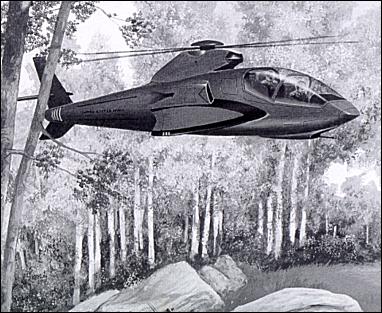
| Bell/McDonnell-Douglas LHX 1991 - project |  |
 |

| Bell/McDonnell-Douglas LHX 1991 - project |  |
 |
|
Although they ultimately lost the competition, Bell Helicopters and McDonnell Douglas undertook a great deal of design and development work, using their combined research and development experience, to design their own version of the next generation light attack/ armed reconnaissance helicopter. As part of their contribution to the Advanced Rotorcraft Technology Integration (ARTI) program. Bell already had experience in high technology cockpit design and developed a fly-by-wire Automatic Flight Control System (AFCS) that allowed the pilot to undertake other tasks, while the AFCS undertook the flying task. This was tested in a trial Huey Cobra. Bell were also advancing their use of composites under another funded program called ACAP. The Advanced Composite Air-frame program (ACAP) was designed to incorporate advanced composites into helicopter airframes and in August 1985, Bell flew their first composite experimental helicopter based around the dynamics of a Commercial Bell Model 222. The ACAP helicopter was used to demonstrate the benefits of composites for design strength, weight reductions and crash impact resistance. It was also used to test different types of composites for different parts of the airframe. McDonnell Douglas Helicopter (MDH) also undertook several research programs relevant to the LHX program. Already successful with their AH-64A Apache design, MDH undertook an Advanced Rotorcraft Technology Integration (ARTI) Program using an AH-64A Apache fitted with an advanced digital flight control system. This demonstrator helicopter first flew in October 1985 and was used to experiment with new technology that allowed 'hands-off' flying. Using advanced flight control systems based around a military standard 1750A processor, it has removed the traditional cyclic, collective and foot pedal controls and replaced them with a four-way sidearm controller. Using the system, the pilot can put the helicopter into a 60 degree bank, a two-G turn and maintain constant altitude and airspeed. With the computers compensating for different torques, engine speeds etc, the pilot can concentrate outside the helicopter; he only needs to flex his hand on the sidearm controller for full manoeuvrability. Another important project undertaken by MDH was their research into the 'No-tail-Rotor' (NOTAR) concept. Replacing the tail-rotor by an internal tail fan with air circulation slots, a converted Army OH-6A helicopter was first flown on 17 December 1981. In 1985 a modified composite fan was fitted to an MD500E and flown in March 1986. The system used a variable-pitch fan forcing low pressure air into a hollow tailboom where the air is vented through slots along the right side of the boom and through a thruster at the end. There are many advantages in replacing the vulnerable tail rotor by an internal fan. In military terms helicopters are able to operate closer to objects without the fear of a tail-rotor strike and NOTAR helped to expand the helicopter's flight envelope increasing sidewards and rearwards flight speeds and yaw stability. It is also less susceptible to damage, with tests showing the system remaining effective after severe damage to the tail boom. All these new concepts including the advanced cockpit technology, Bell 680 rotor system and McDonnell Douglas NOTAR (no-tail-rotor) system were all incorporated into the SUPER TEAM's LHX design. Although their design eventually failed to win the competition, their research and development experience was not lost and can be found on new generation helicopters like the Bell 407, 430 and McDonnell Douglas MD900 Explorer. P.Allen "The Helicopter", 1996
| ||||||||||||||||||||||||

|
|
 |
The project was classified. Releasing real drawings was a violation of security. Our team followed procedure while our competitors didn't.
You won't find them.
I was the lead RCS engineer and had 100% signoff on the exterior. Given time I might be able to reproduce it.
Of course it looks a bit like the RAH-66, it was YRAH-65 in the same competition.
I can tell you - it didn't look a thing like our cartoon you've shown here.
reply